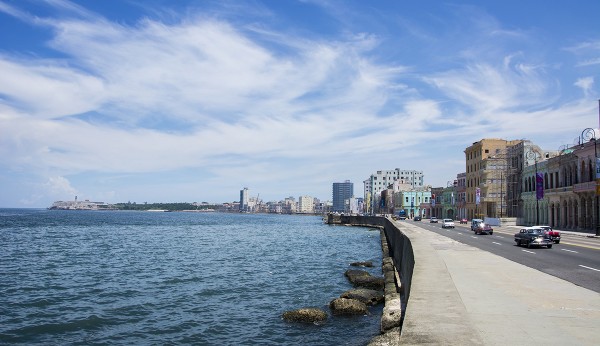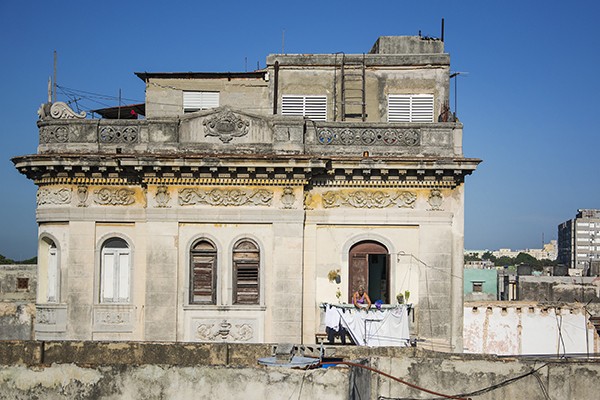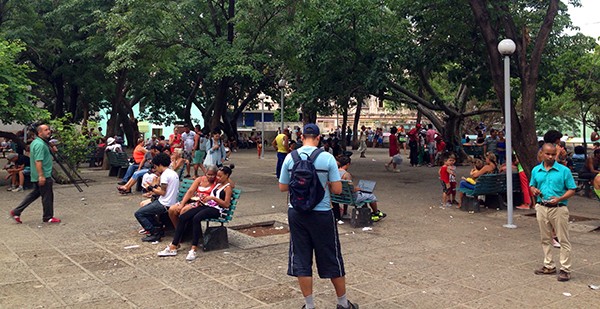Cuba is one of those countries that everyone is aware of its existence, yet not a lot of people know much about it. The country, as famous as it is, still hides much of its intricacies behind a veil of what I think is misinformed fear and cautious curiosity – especially if you’re American.
Growing up in Puerto Rico –an American territory– made me see Cuba as the forbidden land, that should I visit it, I would be either refused entry by the Cubans or face the consequences with Uncle Sam.
After visiting the country for the first time, none of them turned out to be true, especially the former. Having said that, traveling Cuba as an American is still no regular trip. There are travel limitations set by the U.S. through the embargo that forbids most American travelers wishing to visit Cuba and don’t fall under the current 12 categories of authorized travel to the country.
 http://www.globotreks.com/wp-content/uploads/2015/09/Malecon... 600w, http://www.globotreks.com/wp-content/uploads/2015/09/Malecon... 1200w" sizes="(max-width: 600px) 100vw, 600px" />
http://www.globotreks.com/wp-content/uploads/2015/09/Malecon... 600w, http://www.globotreks.com/wp-content/uploads/2015/09/Malecon... 1200w" sizes="(max-width: 600px) 100vw, 600px" />Malecon in Havana, Cuba
But still, this doesn’t mean all is lost for us. For decades, Americans have used the “trampoline method” where they travel to a “layover country” (like Mexico) before flying to Cuba. An important detail of this method is to enter the layover country and check-in your flight to Cuba from there so you can buy your Cuban “Tourist Card” at the airport.
First Impressions Of A “Different World”
Before moving forward, I want to say something… NO, Cuba is not stuck in time. As beautiful and ideal to the traveling eye this cliché might be, this is simply not accurate. Yes, it has developed to the beat of its drum, which for better or worse goes at a slower and irregular pace; but stuck in time it isn’t.
In my opinion, Cuba has created its own development course to work around its internal lackings and its external constrictions (like the embargo).The famous poet, Lola Rodriguez de Tió once wrote, Cuba y Puerto Rico son de un pájaro las dos alas… which roughly translates as “Cuba and Puerto Rico, of a bird, its two wings.” While I only got to learn about this quote once in Cuba, I already knew of the physical and cultural similarities both “sister islands” have. In my mind, I was up to see a poorer, less developed Puerto Rico.
But, I was wrong.
As soon as I arrived at Havana’s Jose Martí Airport and hopped on my taxi, I started to get the feel of Cuba’s social and political environment. Unlike most countries, there are no commercial signs on the side of the road in Cuba. They are all political messages, socialist encouragement, criticisms to the embargo, and almost deified images of key political figures like Fidel Castro, Ché Guevara, and Camilo Cienfuegos.
 http://www.globotreks.com/wp-content/uploads/2015/09/Revoluc... 600w" sizes="(max-width: 600px) 100vw, 600px" />
http://www.globotreks.com/wp-content/uploads/2015/09/Revoluc... 600w" sizes="(max-width: 600px) 100vw, 600px" />
Patria o Muerte, Revolución, Bloqueo, and Socialismo o Muerte are some of the words I saw on a recurring basis; painted on walls and signs along major streets and avenues. The smell of smog floated all around the city – a negative effect of the old engines of the beautiful American vintage cars or the famous Russian Ladas or similar Soviet makes. Still, it was a delight to see so many vintage cars in all stages of conservation, roaming all around the city, as if it was the 1950s. La Havana proved to be a world of itself. It was so full of life, color, and local traditions I didn’t expect to see right away.
 http://www.globotreks.com/wp-content/uploads/2015/09/Havana-... 600w" sizes="(max-width: 600px) 100vw, 600px" />
http://www.globotreks.com/wp-content/uploads/2015/09/Havana-... 600w" sizes="(max-width: 600px) 100vw, 600px" />
I loved seeing how people spend their time on the streets. Whether it is just cultural or the fact that houses get so hot, and most people cannot afford to buy a fan and let alone air conditioning, most people gather in front of their houses and sit on the sidewalk to talk to their neighbors or friends – until very late at night. In fact, everyone seems to know everyone in their neighborhood. In my opinion, this sense of belonging is essential in the Cuban character, and I believe it is one of the reasons why crime is not that high in the country and why Cubans are very friendly.
 http://www.globotreks.com/wp-content/uploads/2015/09/Havana-... 600w" sizes="(max-width: 600px) 100vw, 600px" />
http://www.globotreks.com/wp-content/uploads/2015/09/Havana-... 600w" sizes="(max-width: 600px) 100vw, 600px" />
Going Deeper And Meeting Cubans
As usual, meeting and talking to people is one of my favorite things to do to get to know a place. I like hearing their stories and their perspective on the place they live.
For me, Couchsurfing is a great way to introduce myself to locals, and Cuba was no exception for this mean. But, not surprisingly, Couchsurfing in Cuba is not your typical experience. I mean, it is Cuba after all, and as I discovered, everything there can be a hassle and a regulation. It is complex to say the least.
Unlike most countries, Couchsurfing is not “legal” in Cuba since hosting strangers in someone’s home is illegal. Instead, Cuba has what they call Casas Particulares, which are rooms for rent at someone’s house, or even full apartments to rent in some cases. Locals, instead, use Couchsurfing as a way to promote their Casas Particulares.
While I usually don’t like finding people who charge on Couchsurfing, in Cuba, that’s the only way to do it. Locals are required to pay for a monthly “accommodation license,” charge for the night, and register every person who stays with them and report them within 24 hours in the regulating agency. (Airbnb is also an excellent site to find Casas Particulares. With this link you get $25 off your first booking anywhere in the world.)
What about visiting a friend? You can stay with a friend for free, but your friend has to get the approval from the agency by showing proof of your friendship – like photos together, email conversations, and such.
In the end, I was happy with my host, Lis, and I gladly recommend her to anyone going to Havana. She was the best, and she gave me so much insight of Cuba, its history, and customs, from her firsthand perspective.
 http://www.globotreks.com/wp-content/uploads/2015/09/Havana-... 600w" sizes="(max-width: 600px) 100vw, 600px" />
http://www.globotreks.com/wp-content/uploads/2015/09/Havana-... 600w" sizes="(max-width: 600px) 100vw, 600px" />Part of the view from my window. I could see this lady washing her clothes on a regular basis.
Through her, I learned a bit more about the embargo, from the Cuban perspective, and how lifting it would be so beneficial for the local commerce and the country. This would allow more goods to be imported from nearby countries (including the U.S.), not just from China and Russia, which are the current main importers – with a high transport cost. Currently, under the embargo, any cargo ship that docks in Cuba is forbidden to trade or transport goods from/to the U.S. for six months. Naturally, many companies/countries shy away from dealing with Cuba since the U.S. presents a better economic alliance.
I’ve always thought of the embargo as unnecessary, and while it still stands strong, it looks like the U.S. and Cuba are on the right path to forge a better diplomatic relationship, just like they had at the beginning of the 20th century.
I loved seeing the dichotomy of government mentality and the public’s perception towards the U.S. On one side, you have the government (in its majority) speaking on the evils of the imperialist U.S, yet on the other side, Cubans are very friendly and welcoming to Americans and everyone alike. It is quite inspiring to see them being so open to what some would say “their oppressors.”
The Hassles Of “Everyone Is The Same”
As I already mentioned, everything is a hassle in Cuba – even for tourists. But maybe, these hassles are the closest we get to experience life there – even if it is miles away from what life really is there. Fidel’s ideals, through socialism, “establish” that everyone is the same. As utopic as this may sound, the reality is far from that. But still, most people are measured by the same yardstick that offers little variance.
If you work for the state, the minimum salary is around $10 a month, the mean is around $20, and doctors earn around $35… A MONTH! Doctors!
With doctors, for example, locals understand the valuable service they provide and the sacrifice and hard work it took to become a doctor. For them, doctors don’t deserve that “we are all the same” low wage, so they try to help by showing their appreciation for the work the doctor is providing. For this reason, when locals go to the doctor, they bring gifts in the form of food or daily use items. On one hand, this is an excellent help for the doctors who appreciate it; on the other, some doctors are taking advantage of it and offer “better service” for better gifts. It’s a double edge sword.
 http://www.globotreks.com/wp-content/uploads/2015/09/Havana-... 600w" sizes="(max-width: 600px) 100vw, 600px" />
http://www.globotreks.com/wp-content/uploads/2015/09/Havana-... 600w" sizes="(max-width: 600px) 100vw, 600px" />
The daily life challenges also permeate slightly into the tourist’s experience. Changing money often comes with long queues, finding good food is a hit and miss experiment, haggling transportation prices is not uncommon, and even buying snacks is a challenge on its own.
Maybe I missed them all, or maybe they don’t exist, but I failed to see a single supermarket as I know it. Yes, I saw a few markets, but they were mostly empty and only provided the basics like rice, beans, flour, oil, soap, and other items of first need. Cookies? What’s that?!
As I learned, some markets are dedicated to selling only the “rations” food. Cuban families get a “rations coupons book” that provides them a certain amount of food for the whole family for a month. They still need to buy it, but the entire month’s worth of food will cost them no more than $1. This amount of food is not enough to eat well, but enough to not starve. Some families do have to buy extra food with what little money they have, and that ends up being the basics, which is what’s seen in most other semi-empty “regular” markets.
While this is generally true, the other reality I found in Cuba is that foreign products are slowly making their way in, like Brazil’s Brahma beer, Pringles Chips, and Coca-Cola. The latter was easier to find than I expected. Maybe the result of Raul Castro’s more progressive mentality is slowly speeding Cuba’s development. Still, it is a difficult development. Fidel destroyed Cuba’s economy, and the country is still struggling to get out of the economic hole he dug with his ideals, domestic policies, and foreign trades.
Since about four years ago, Cubans can now buy and own property (up to two properties), instead of “permuting” it or exchanging as it was only allowed before under Fidel’s rule. People can now hire employees outside their family circle and own a business. Before, people could not buy new cars, but only transfer the ownership of cars obtained before the revolution. This is one of the reasons why you can still see so many vintage cars there. Now, people can buy “modern” used cars, or if they’re financially well, a new car.
And then there’s the internet…
The Internet Is Still A Social “Thing”
One of the most curious things I saw there was the use of the internet, from its most “primitive form” to the most “technological.” But one thing stood out within that spectrum; the internet in Cuba is still a social and shared phenomenon.
Not everyone can afford to buy the newly introduced WiFi cards that allow you access to the internet at select public hotspots. What they do is gather together among friends and family to use the limited access as a collective. They all Skype together to their families abroad, they chat on Facebook as a quasi-real chatroom, and even their Google searches are done in collective. Unlike us in other countries, where the internet use has become a one on one interaction between us and our device, in Cuba it is still many voices to one device.
 http://www.globotreks.com/wp-content/uploads/2015/09/Fe-del-... 600w" sizes="(max-width: 600px) 100vw, 600px" />
http://www.globotreks.com/wp-content/uploads/2015/09/Fe-del-... 600w" sizes="(max-width: 600px) 100vw, 600px" />See them mostly paired while using wifi? Still a social gathering!
Those who can’t afford WiFi access but want to stay in the loop of what’s happening, resort to buying “offline internet packages.” These packages are downloaded videos, movies, series, and saved news of “the best” of the week. One guy is in charge of curating the internet and once a week he delivers the content by visiting his clients –who pay $5 per week on average– to transfer the data. In theory, one person’s internet becomes everyone’s internet. Still, it is not cheap, but when there’s no other way of accessing the world wide web, this is their best option available.
The Evolving Cuba
These days I hear the common expression, “we have to go to Cuba before it changes and gets ruined,” or something along those lines. To that I think, change is inevitable and whatever change comes to Cuba shouldn’t be seen as “ruining” the country. I don’t see people claiming that the US has ruined itself because we no longer dance, dress, and build like in the roaring twenties. Progress has been good for us and inevitably it will be good for them too. Cuba has struggled a lot, so it has the right to forge a different future.
 http://www.globotreks.com/wp-content/uploads/2015/09/Che-Hav... 600w" sizes="(max-width: 600px) 100vw, 600px" />
http://www.globotreks.com/wp-content/uploads/2015/09/Che-Hav... 600w" sizes="(max-width: 600px) 100vw, 600px" />
It is up to Cuba to decide how and what to evolve and how to conserve the culture and social environment that has made it such an intriguing and somewhat “off-limits” destination. Whatever it is, I’m sure it will still conserve the core of not only Fidel’s socialist Cuba, but also the Spanish’s Cuba, and Jose Martí’s Independent Cuba.
Do you want to see the Cuba that has been widely clichéd for decades? Then go now, as that Cuba will evolve at its own pace, and it seems to be picking up some speed and the floodgates slowly open.
My First Impressions On Cuba is a post from: GloboTreks.
Check out my monthly newsletter for additional tips, advice, and updates on travel.